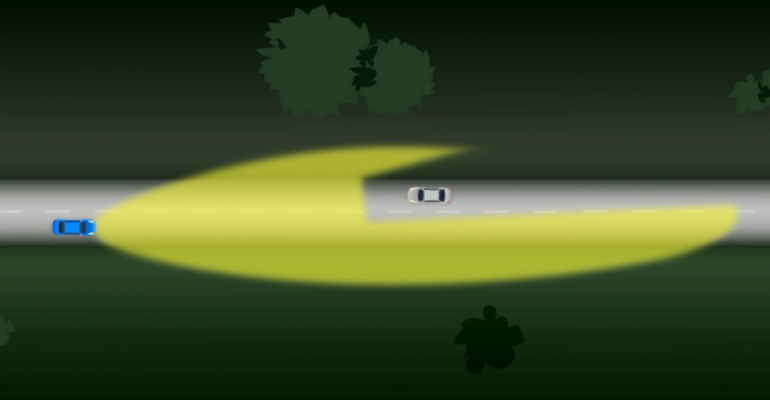DETROIT – When driving down a dark country road, high-beam headlights are best to detect possible obstacles ahead.
But they’re not great for drivers in oncoming vehicles, who can be blinded by their glare.
It’s a conundrum nearly old as the automobile.
That’s why Varroc Lighting Systems is pushing for the U.S. to follow the United Nations Economic Commission for Europe’s acceptance of adaptive-drive-beam technology.
ADB marries high- and low-beam technology in a single headlight and eliminates the need to manually switch from high to low beams in the face of oncoming traffic. However, unlike current adaptive-lighting technology, the high beam is not turned off.
“High-beam is on 100% of the time, but the high beam is being adapted to its environment, so as it sees oncoming traffic, it automatically shuts off a window around what it sees coming – there’s no driver intervention,” Scott Montesi, director-product development for Varroc, tells WardsAuto here at the 2016 SAE World Congress.
With ADB, beam patterns are adapted so shadowed areas are created for drivers in oncoming vehicles or those who may be ahead of the ADB-equipped vehicle and annoyed by high-beam glare in their mirrors.
Out of a matrix of LEDs, six or seven out of maybe 30-40 LEDs are switched off to create a black-box effect, says Rainer Neumann, vice president-global technology for Varroc Lighting Systems.
The other LEDs remain in operation, illuminating the other side of the road.
Neumann says studies show ADB improves visibility 98 ft. (30 m) at speeds of 45 mph (60 km/h), giving a driver 1.3 seconds more time to react to obstacles in the road.
Audi last year announced the University of Michigan’s Transportation Research Institute and Rensselaer Polytechnic Institute of Troy, NY, were testing its ADB technology, which it calls matrix-beam LED and already is on Audis sold in Europe.
Toyota also has been a proponent of ADB, petitioning NHTSA to allow the technology.
Varroc officials say the company’s ADB system will be on a European model within the year.
Varroc next week is meeting with the SAE lighting committee and NHTSA to discuss ADB. Neumann believes approval of the technology is imminent, thanks to studies NHTSA has done of European ADB-equipped models.
“I think (the) beginning of next year (it) should be possible to also release these systems (in the) U.S.,” he says.
Varroc Lighting will demo the technology for media next month near its Plymouth, MI, U.S. headquarters, but Montesi says oncoming drivers shouldn’t be able to perceive the black-box effect from the ADB system. “It essentially shadows around your vehicle, so your perception (of the ADB headlights) will look no different than if it’s in a normal low-beam mode.”
Varroc’s ADB technology, one of several such systems from automotive-lighting suppliers, works in concert with existing cameras that control advanced safety functions such as lane-departure warning and forward-collision warning. These same cameras can detect headlight movement from an approaching car.
“We can click in our (ADB) headlamp practically to this (type of) camera,” says Neumann, who notes ADB is a less expensive lighting technology than bi-xenon high-intensity discharge lamps.
Like most new lighting technology, it probably will appear first in premium models, but Montesi says it can be made affordable for mass-market applications.
“A lot of the lighting space has grown over the last 10 years to be jewelry for the car, a lot of whiz-bang stuff,” he says. “But this is actually one of the first safety applications that has advanced lighting technology in a while. Safety shouldn’t just be at the upper end, it should be for the entire marketplace.”
However, as the technology works in concert with LEDs, it’s worth noting LED headlights typically are available on only the highest grades of mass-market vehicles in the U.S.
From Visteon to Varroc
In 2012, Indian supplier Varroc purchased the former Visteon lighting division for $72 million.
Montesi says the acquisition has been a successful one. Visteon, as a large, multi-focused supplier, never could justify devoting many resources to its lighting division, he says.
“Lighting was the smallest of their four divisions, so…whenever we needed capital infusion or whatnot, we would bring that to the board and (be told), ‘Great idea, of course we can better spend the capital on one of the larger groups,’” he says.
At Varroc, lighting comprises more than half its portfolio by revenue so “we get a lot more attention placed on us. It’s alleviated a lot of the pressure we had before,” Montesi says.
Unlike with Visteon, where former owner Ford was its main customer, Varroc counts as customers all the Detroit Three automakers, as well as Skoda, Daimler, Tata, Mahindra & Mahindra, Suzuki, Volkswagen and one up and coming OEM you may have heard of.
“One of our bigger customers now is Tesla Motors,” Montesi says. “We have all of their brand lighting that they’ve launched in their vehicles to date.”





